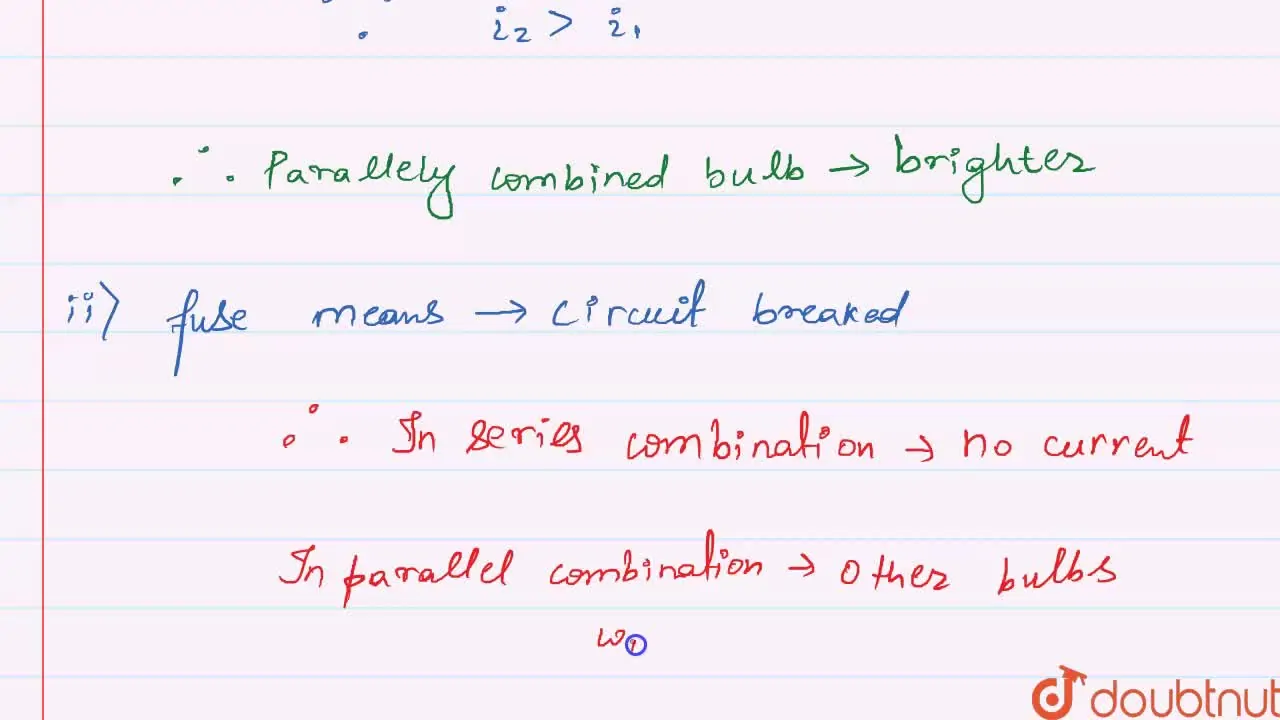Three incandecent bulbs of 100W each are connected in series in an electric circuit. In another circuit another set of three bulbs of the same wattage are connected in parallel to the same source.
(a) Will the bulbs in the two circuits glow with the same brightness ? Justify your answer.
(b) Now let one bulb in both the circuits get fused. Will the rest of the bulbs continue to glow in each circuit ? Give reason.
(a) Let us assume that the resistance of each bulb be R. The circuit diagram in two cases may be drawn as given below

Equivalent resistance in series combination R3=R+R+R=3R, voltage = V
Let current through each bulb in series combination be I1. By Ohm's law,
V=I1×3R⇒I1=V3R
So, power consumption of each bulb in series combination.
P1=I21(3R)=(V3R)2×3R=V29R2×3R
=V23R=V23R ....(i)
For parallel circuit, (1)
The resistance of each bulb = R
Voltage across each bulb = V [∵same voltage in parallel combination]
∴ Power consumption of each bulb in parallel combination.
P2=V2R ....(ii)
∵ From Eqs. (i) and (ii). we have P2P1=V2/RV2/3R
V2R×3RV2=3⇒P2=3P1
Therefore, each bulb in parallel combination glows 3 times brighter to that of each bulb in series combination.
(b) When one bulb fused in both the circuit, then in series combination, circuit gets broken and current stops flowing and remaining bulb don't glow. Whereas in parallel combination, same voltage continue to act on the remaining voltage and hence, other bulbs continue to glow with same brightness.
Related Playlists
Similar Questions
When two electric bulbs of 40W and 60W are connected in parallel, then the:
View SolutionThree bulbs of 40W,60Wand100W are connected in series with a 240V source.
View SolutionTwo electric bulbs A and B are rated as 60 W and 100 W . They are connected in parallel to the same source. Then,
View Solution3 identical bulbs are connected in series and these together dissipate a power P . If now the bulbs are connected in parallel, then the power dissipated will be
View SolutionTwo electric bulbs AandB are rated 60and100W, respectively. If they are connected in parallel to the same source , then
View SolutionTwo bulbs when connected in parallel to a source take 60 W each, the power consumed, when they are connected in series with the same source is
View SolutionTen 60 W, 220 V bulbs are connected in series to 220 V supply . Power consumed in the circuit is
View SolutionIn an electrical circuit three incandescent bulbs A,BandC of rating 40W,60Wand100W respectively are connected in parallel to an electric source. Which of the following is likely to happen regarding their brightness ?
View SolutionTwo bulbs when connected in parallel to a source take 100 W each. The total power consumed when they are connected in series with the same source is
View SolutionAn electric bulb and a capacitor are connected in series with an AC source.On increasing the freqency of the source, the brightness of the bulb
View Solution


